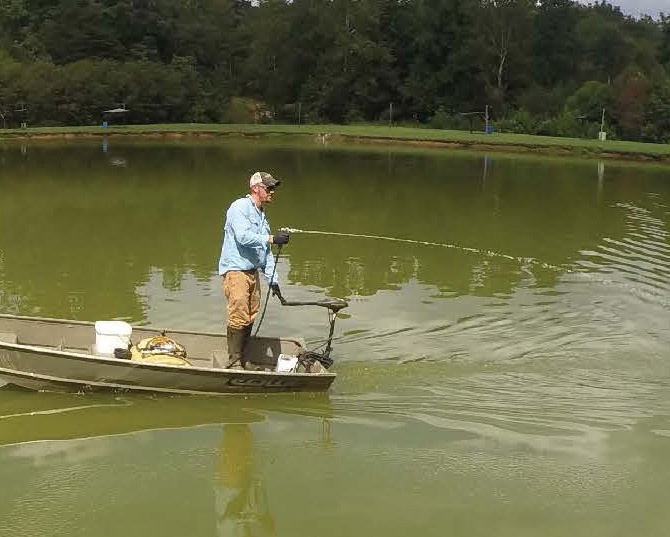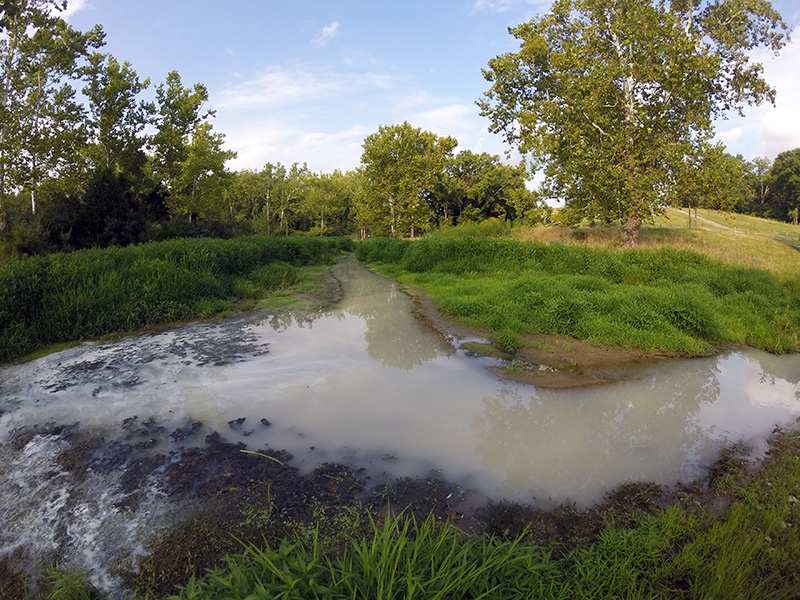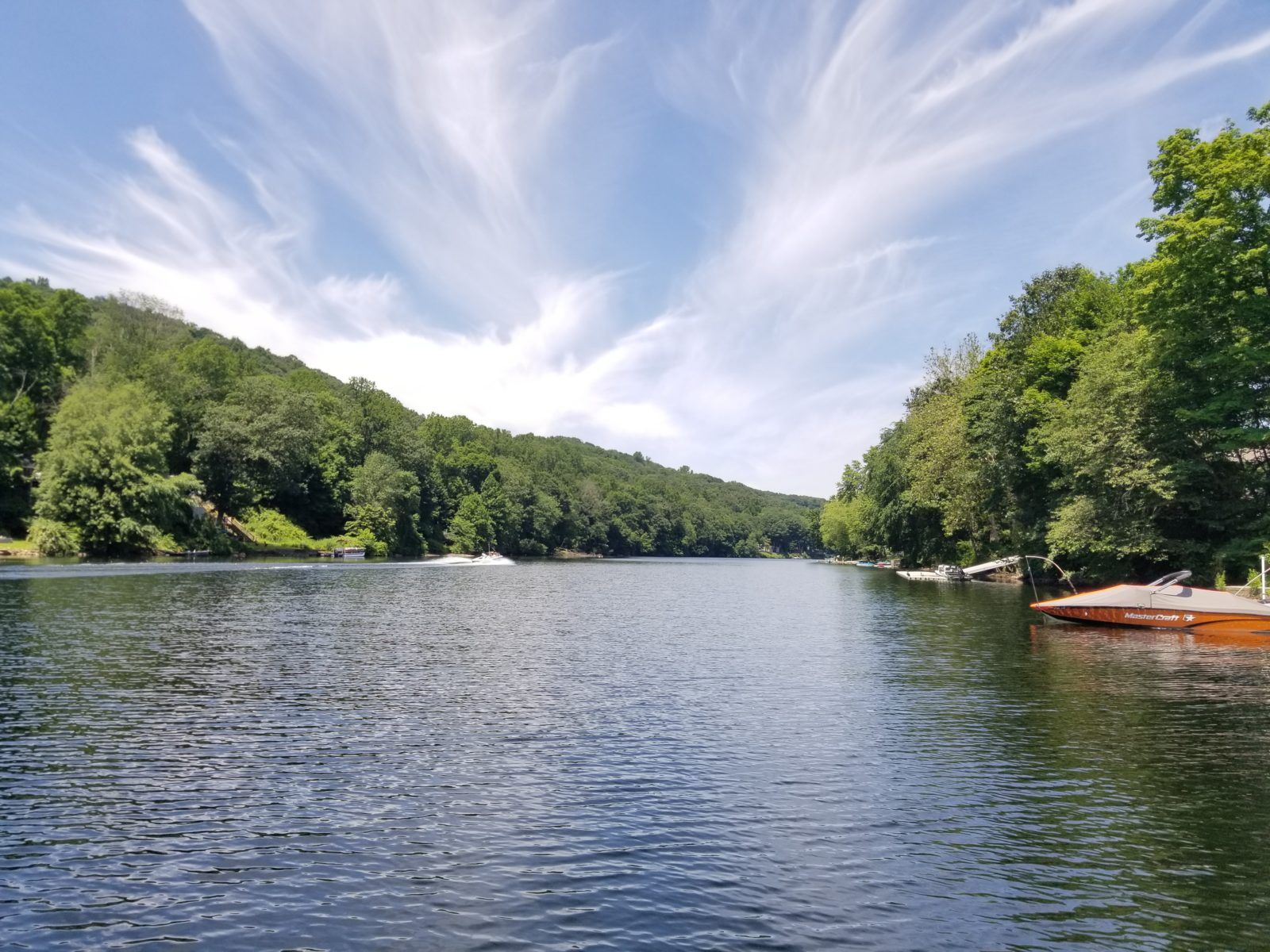Fisheries Management: Resetting Fisheries
February 19th, 2016
AS SEEN IN Pond Boss Magazine, Written by David Beasley, Fisheries Biologist and Director of Fisheries
 It may be a surprise, but it was only a few decades ago that private land owners began pursuing the art of trophy bass management. Until the late 1900’s, ponds were primarily viewed as a source for food or water for livestock. Over the last 35 years, landowners began wanting more out of their ponds, and as a result, management strategies have gradually developed through trial and error. Thanks to pioneers of this industry, and lessons learned the hard way, current management strategies have progressed and increased the odds of successfully establishing a trophy fishery. One of the most important lessons learned over the years is that either new ponds or fisheries that have been reset (started over) have a much higher probability of producing trophy caliber fish than trying to manage an existing, older fishery. This process of building a fishery from ground zero provides pond owners much greater control over the outcome. As more and more pond owners across the country are pursuing their dreams of growing trophy-caliber bass, the concept of resetting waterbodies is trending. Although resetting ponds has become a valuable fishery management strategy, many people find themselves with some level of uncertainty when it comes to proper resetting techniques. As a result, it is common for people to fail in their attempt to reset their fishery. The worst part surrounding an unsuccessful reset is it often takes a year or two before the trouble is realized, and at that point, the landowner has too much invested to restart the process correctly.
It may be a surprise, but it was only a few decades ago that private land owners began pursuing the art of trophy bass management. Until the late 1900’s, ponds were primarily viewed as a source for food or water for livestock. Over the last 35 years, landowners began wanting more out of their ponds, and as a result, management strategies have gradually developed through trial and error. Thanks to pioneers of this industry, and lessons learned the hard way, current management strategies have progressed and increased the odds of successfully establishing a trophy fishery. One of the most important lessons learned over the years is that either new ponds or fisheries that have been reset (started over) have a much higher probability of producing trophy caliber fish than trying to manage an existing, older fishery. This process of building a fishery from ground zero provides pond owners much greater control over the outcome. As more and more pond owners across the country are pursuing their dreams of growing trophy-caliber bass, the concept of resetting waterbodies is trending. Although resetting ponds has become a valuable fishery management strategy, many people find themselves with some level of uncertainty when it comes to proper resetting techniques. As a result, it is common for people to fail in their attempt to reset their fishery. The worst part surrounding an unsuccessful reset is it often takes a year or two before the trouble is realized, and at that point, the landowner has too much invested to restart the process correctly.
One fundamental concept of the reset process is to understand why resetting is such a successful management strategy. If successful, you eradicate existing fish, and then are able to develop a thriving forage base as well as limit the number of predators initially stocked into the system. The process of allowing the forage base to establish properly sets the fishery up for success for several years. During restocking, it is typical to stock small, young forage fish since they cost less. This process of stocking small forage will expose a big risk of failure if any predatory fish species survive the reset process. If a fish population is properly eradicated, success is higher. If not, and even a few predator fish survive, success is fleeting. If you fail to successfully reset the pond, it is likely that instead of a thriving forage base, the low number of predators that were not eradicated will clean up all of the small forage fish you stock, leaving you with a fishery that falls short of your goals. The first step to a successful reset is having the correct mindset. Since a clean start is critical to the success of the fishery, and since you are rarely in a position to reset a fishery, it is important to take it seriously. Far too often, people say convincingly that they know that no fish are alive in the remnants of a waterbody. Without draining, it is difficult to know zero fish are alive. Rather than making the assumption nothing is present, the correct action is to properly apply the appropriate rate of rotenone, a widely used restricted-use natural fish toxin, to ensure the waterbody is void of fish. Consider following up, several weeks after rotenone application, by sampling the lake, looking for survivors. Depending the size of the lake, it is wise to have someone electrofish, or at the least, pull a short seine around different areas of the perimeter, looking for remaining fish. Existing waterbodies that are being reset, but are not being drained, are typically at a much higher risk of failing to achieve a 100 percent reset. This is because many variables come into play that increase the chance of failure, such as small coves where fish can escape, or maybe deep water where it’s difficult to apply the rotenone. To ensure success, one of the first steps is to obtain a good understanding of the waterbody’s water volume. This process requires mapping the waterbody using sonar or collecting manual points and plotting them on a map. Once you know how many acre-feet of water are present, you can then properly estimate how many gallons of rotenone would be needed to complete the application. Rotenone can be an expensive product, so, to save money, it typically makes sense to draw the water level down as much as reasonably possible, except in drought-prone areas. An additional benefit to drawing down the water level is the improved chance that fish cannot find a spring or pocket of fresh water and survive the treatment.

Applying a low dose of rotenone to kill gizzard shad.
In addition to the amount of water within the waterbody, you will want to determine if other waterbodies pose a threat to disrupting your reset process. The first places to consider are ponds upstream and downstream. Waterbodies downstream likely pose less risk, but if your site has a spillway that would allow fish to swim into your waterbody, you may consider modifying the design. Water upstream of your pond is a larger threat. Fish moving downstream, especially during large rain events, is a realistic occurrence. Consider upstream threats and determine if fish can easily travel downstream. If so, modify your management strategy to reset upstream waterbodies, or do it at a time least likely to offer fish movement, such as the driest, hottest time of the year. Or, simply assume you may not successfully reset your fishery as you expect. That means you may need to rethink your re-stocking strategy. Other threats to a successful reset are neighboring waterbodies that could connect with your waterbody, or flow into it when the water table is high. This could be a small neighboring pond or ditch not seen as a risk, but during times of high water, would allow fish to pass from one waterbody to the next. If you have neighboring water that poses a threat, it is best to take it into consideration as you formulate your strategy. When it’s time to apply rotenone, proper application techniques and rate of application will increase the odds of success. Many use the strategy of a half-gallon of rotenone per acre-foot. If catfish, bullhead, green sunfish, or other hardy fish are present, it is typical to increase the rate to one gallon per acre-foot. Proper application means mixing rotenone from the top to the bottom of the water column. Rotenone, a derivative of the root of a tropical plant called Derris, is oily. It doesn’t really mix into the water, it emulsifies. That means it must be pumped deep into the water to get the best mixing possible. Some strategies entail pumping liquid rotenone into the shallower water, and using powdered product, wetted and made into balls about as big as softballs, which are then tossed into the deeper water. But, the best way by far, is to pump it throughout the water column from a boat, emulsifying the material as you go. Waterbodies thick with mats of vegetation should have the vegetation controlled prior to applying rotenone. Dense stands of vegetation provide fish a place to ride out the treatment, especially if a spring is located within the dense vegetation growth, or if the plants restrict the flow of treated water. If controlling vegetation is not practical, then inject rotenone into stands of vegetation.

Rotenone applied to a creek/pond inflow.
The length of time rotenone is active will vary depending on water temperature, so it is critical to take steps necessary to prevent water outflow prior to the rotenone deactivating, or you should plan to apply potassium permanganate to deactivate the rotenone. You don’t want to kill fish downstream. During summer, when water temperatures are in the 80’s or higher, the rotenone can deactivate in as little as a week, while in cooler months it can take several weeks. If your situation does not allow waiting the appropriate amount of time prior to water leaving your site, plan to deactivate rotenone by applying 55 pounds of potassium permanganate per acre of water. Since rotenone breaks down rapidly in warmer water, it is often safer and more cost effective to apply when water temperatures are warmer. This will allow the rotenone to naturally deactivate in a short period of time and minimize risk of exposure downstream. Just like any application of pesticides to water, each state has policies and regulations to help ensure any products applied to water are being used responsibly. Prior to proceeding with the rotenone process, it is important that you make sure you are in compliance with your local jurisdiction. Overall, the process of resetting fisheries is a fairly simple concept, but unfortunately many sites present a moderate risk of failure. The success of resetting your fishery is greatly dependent on your diligence. If you have any questions or concerns before or during the reset process, do not hesitate to reach out to an experienced professional and let them work with you to ensure your success.
Contact the experts at 888-480-5253 for all of your lake, pond and fisheries management needs.
David Beasley is a Fisheries Biologist and Director of Fisheries with SOLitude Lake Management. Since 1998, SOLitude Lake Management has been committed to providing full service lake and pond management services that improve water quality, preserve natural resources, and reduce our environmental footprint. Lake, pond and fisheries management services, consulting, and aquatic products are available nationwide. Learn more about SOLitude Lake Management and purchase products at www.solitudelakemanagement.com.










